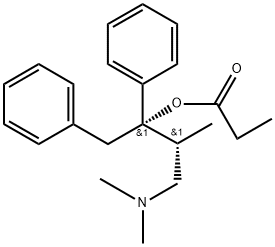
デクストロプロポキシフェン
化学名:デクストロプロポキシフェン
CAS番号.469-62-5
英語名:PROPOXYPHENE
CBNumberCB4716127
MFC22H29NO2
MW339.48
MOL File469-62-5.mol
别名
[2S,3R,(+)]-4-ジメチルアミノ-3-メチル-1,2-ジフェニル-2-ブタノールプロピオナート
(+)-プロポキシフェン
プロピオン酸(1S,2R)-1-ベンジル-3-(ジメチルアミノ)-2-メチル-1-フェニルプロピル
more
デクストロプロポキシフェン物理性質
| 融点 | 75-76° |
| 比旋光度 | D25 +67.3° (c = 0.6 in chloroform) |
| 沸点 | 475.43°C (rough estimate) |
| 比重(密度) | 1.0751 (rough estimate) |
| 屈折率 | 1.5614 (estimate) |
| 闪点 | 2℃ |
| 貯蔵温度 | 2-8°C |
| 酸解離定数(Pka) | pKa 6.3(50% aq EtOH) (Uncertain) |
| EPAの化学物質情報 | Propoxyphene (469-62-5) |
| 主な危険性 | F,Xn,T |
| Rフレーズ | 11-20/21/22-36-52/53-25 |
| Sフレーズ | 16-26-36/37-61-45-36/37/39 |
| RIDADR | 3249 |
| WGK Germany | 2 |
| 国連危険物分類 | 6.1(b) |
| 容器等級 | III |
| 有毒物質データの | 469-62-5(Hazardous Substances Data) |
| 毒性 | An opioid analgesic similar in structure to methadone. It is a much less potent analgesic than morphine and is devoid of antipyretic or anti-inflammatory effects. Its side effects are qualitatively similar to codeine. The clinical indications for propoxyphene are much the same as for aspirin. It is used when the degree of analgesia required is less than that produced by morphine. Recent clinical trials suggest that propoxyphene is no more effective in controlling mild pain than is aspirin. Because they act by different mechanisms, aspirin and propoxyphene have often been given in combination. Recently, there has been a trend away from use of propoxyphene because its weak analgesic properties do not compensate for other problems with its use. Interestingly, the analgesic activity of propoxyphene resides largely in the dextrorotatory isomer, whereas the antitussive effect is produced primarily by the levorotatory isomer. The use of propoxyphene was banned in the United States in November 2010. The oral LD50 in rats is 84 mg/kg. |

